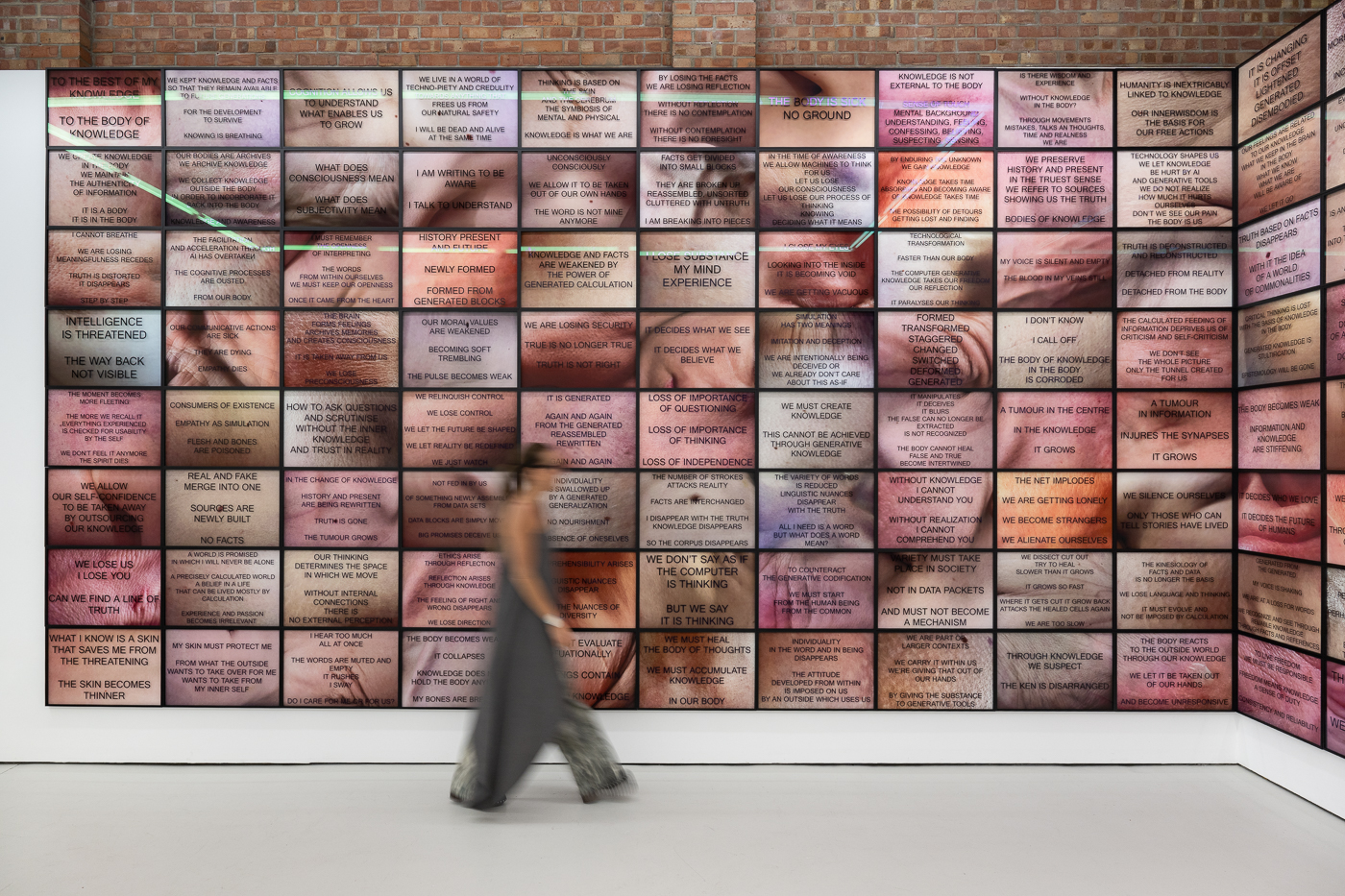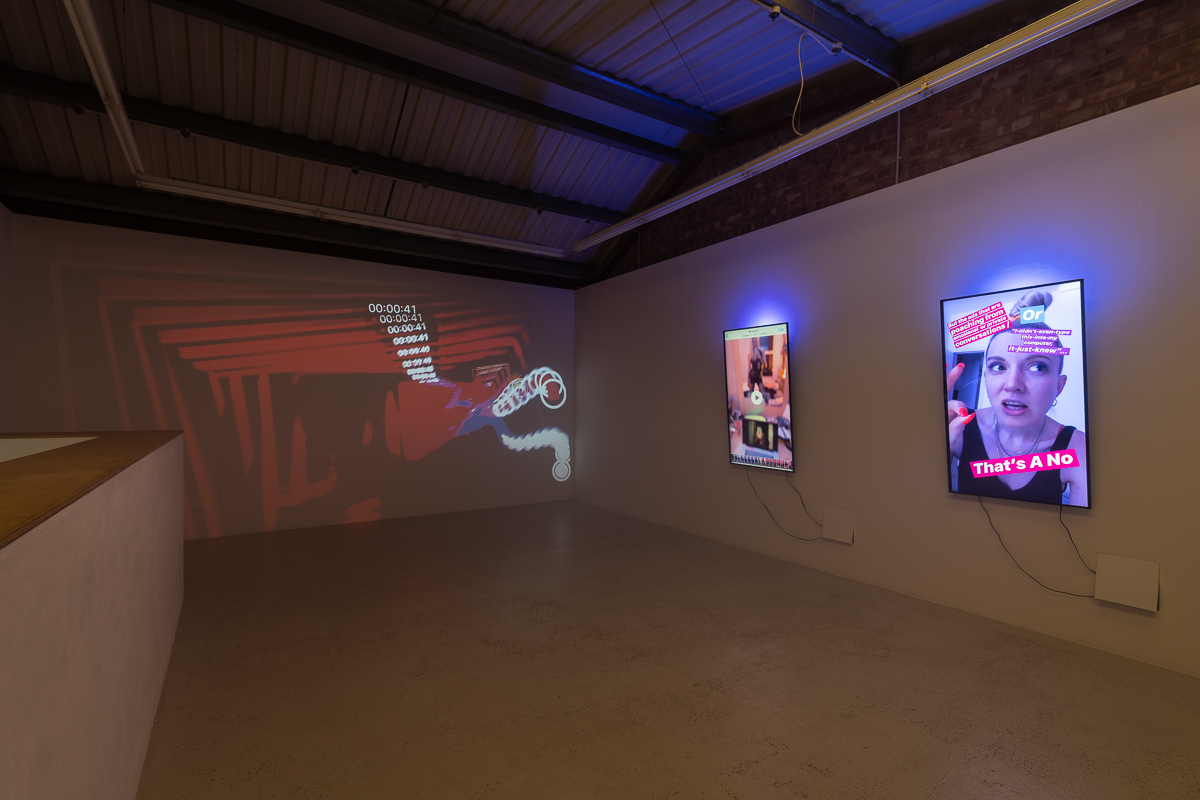Signe Pierce has been interviewed by Alice Bucknell in MOUSSE Magazine, where the writer and artist discuss Pierce’s self-definition as a ‘reality artist’ in an increasingly digital and virtual field, on the occasion of her new show at Annka Kultys Gallery.
“Digital Streams of an Uploadable Consciousness: Stories 2016-2019”: Signe Pierce
By Alice Bucknell
Thick fog wafts through Annka Kultys Gallery in London, diffusing the candy-hued laser beams overhead. Across two screens and a projector, Peggy Gou beats thump to close-up shots of New York City garbage cans as the infinite scroll of an iPhone camera feed flashes into oblivion. This ambient chromatic landscape is the work of Signe Pierce, the self-described reality artist whose work takes up topics of gender and embodiment, surveillance culture and alt-right politics, and simulation and digital interfaces, among other sticky feedback loops. Describing Digital Streams of an Uploadable Consciousness: Stories 2016–2019 as an act of “self-exporting to get to the next phase of my work,”1 Pierce discusses performing on Instagram and working with reality, the toxic negativity of the art world, and what today’s players can do to improve.
ALICE BUCKNELL: Let’s start with the title of the show, Digital Streams of an Uploadable Consciousness: Stories 2016–2019.
SIGNE PIERCE: It’s a phrase that I often use when I’m writing and thinking [about] my media of choice: my life exported and seen by others. It’s also a way of talking about being a “reality artist”—a quest I fully acknowledge to be a paradox—and my attempts to decode what’s happening to reality as we enter an increasingly digital and virtual field. Reality was already difficult enough to conceptualize before we introduced technology, which I consider to be a new dimension. In this exhibition, I’m also interested in building up an archive of digital streams that quantify my reality, as a sort of purging process where I need to export myself before reaching the next stage of my practice.
AB: How do the works on show navigate these ideas?
SP: There are three video works: The first is titled after the exhibition, Digital Streams of an Uploadable Consciousness: Stories 2016–2019 (2019). The second is called When You Die, Your Camera Roll Flashes before Your Eyes (2019). Finally, there is a projection on the back wall, titled Digital Streams of Infinity (Reality Painting) (2019).
The first video piece is a twenty-minute-long amalgamation of my Instagram stories and Snapchats from the past three and a half years—things I’ve uploaded to the Internet to be consumed by people. It’s not chronological, and it’s definitely not cohesive. Sometimes I’m comparing a pile of trash to Dutch still lifes, and in the next story, I’m critiquing tech companies’ abuse of our data. I wanted to create a raw compilation that gives viewers an immediate impression of the type of commentary that I’m interested in creating, as well as the kind of performer that I am. The second piece is basically an expedited infinite scroll through my iPhone’s photo library. If these works were acquired by a collector, they would be periodically updated with new content. I’m interested in examining art world hierarchies and also the currency of digital content. And the third work, the projection, is a sort of billowing browser window, a simulacrum for viewers to get lost in.
AB: You’re well-known for your neon-soaked still lifes that went viral on Tumblr a few years back. How do your social media performances, and your broader performance work, fit into your practice?
SP: I studied acting and writing when I was younger, and I eventually made my way into photography through the lens of performance. So, for me, my practice is like a fusion of all of the above. And the medium I do it best on is Instagram, because it’s so disposable, and so collective. I think of Instagram stories as a group consciousness raising—like the radical feminist activist movement from the sixties applied to the present. The Internet has given us a platform to create global conversations on human injustice which were previously carried out by grassroots initiatives that had a limit or a tap to their impact.
I also see it as a way to stick one leg out of the art world: I work within gallery spaces, so acknowledge my complicity in the system, but I am so frustrated with the way that contemporary art is made inaccessible to people who could really benefit from being surrounded by it. I think a lot about the experience of shooting what’s probably my most well-known film work, American Reflexxx, back in 2015. From the crowd that assaulted me on Myrtle Beach, almost nobody went to the idea that this was art. One guy said, “It’s just pretentious performance art,” but he was the only person within the hour-long performance that had anything to say about it. To me that’s such an obvious example that contemporary art, especially performance art, is happening in such an exclusive realm, and that has to change.
AB: What draws you to the challenge of reality?
SP: Because it’s so hard to qualify and quantify what reality even is. I’m so obsessed with understanding reality that I don’t even have time for fiction. I don’t read novels, I barely watch scripted movies. I like to explore things as they happen, I like live feeds, I like recording stuff and hitting export and making it real immediately. I think about my phone as both my paintbrush and my canvas. I also think a lot about Baudrillard’s ideas of hyperreality, and [about] daily performativity à la Kardashians—if you’re faking something for long enough, your faux life will become your reality. When I was in art school, I remember “post-irony” was the thing; now we’re going into this post-post-post-post-everything, it’s like there is no end to the “post,” and it’s becoming increasingly difficult to configure where we stand.
AB: How does your work relate to principles of accelerationism?
SP: I was first introduced to that term about six years ago by a friend after we watched Spring Breakers (2012), by Harmony Korine, and at first I was really fascinated by it. But over the past couple years, I’ve become increasingly skeptical, mainly because of the pseudo-woke nihilist academia bros who espouse this doomsday philosophy. It’s hard to dislodge my work from it entirely, as it shares the idea that we’re moving into a singularity. I think we’re entering into a singular relationship with technology: our anatomies are merging. The moment you start reading about that, you start realizing how infinite the possibilities with technology truly are. But the crucial difference is accelerationism doesn’t allow for possibility, and for that reason I’m so over it. I am extremely bored of nihilism, of the denial that feeds nihilism, and the convenience of denying accountability. It’s these think tank, podcaster types leading with this sardonic, too-cool-to-care attitude. They say you’re lame if you care because we’re all fucked anyway. With that attitude, we definitely are! It’s like: Who can be the nastiest? Who can be the biggest edge lord, the hardest troll? But my question is: what is the endgame here?
AB: Do you think this attitude seeps into contemporary art?
SP: Definitely. I had this epiphany while flying home from the Athens Biennale last year, which was seeped in so many narratives of despair and hopelessness. The art world definitely hypes denialism, it touts this painfully toxic energy. On that plane, I realized that I’m not going to let anyone gaslight me into acting like that in order to get ahead in the art world.
AB: What can the art world do to improve?
SP: The art world needs to be less forbidding and more accessible to the general public, as well as more attuned to artists’ role beyond cultural producers. I don’t get up in the morning and go to my studio so I can go make a couple pieces that will sit in a Swiss shipping container for the next decade. For people who love art and have some sort of means at their fingertips to curate or program art in a broader scale, it’s vital they think more about the public and the artist as agents in this field instead of pawns.
[1] Conversation with the author, June 2019.
at Annka Kultys Gallery, London
until 6 July 2019


